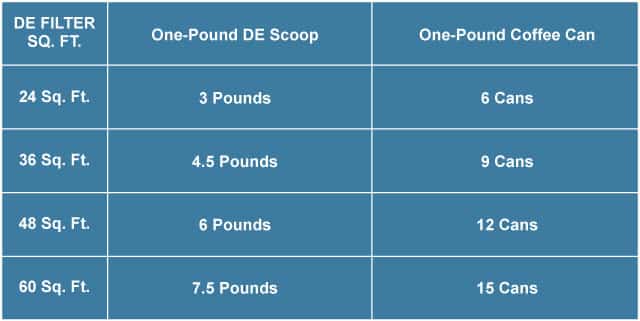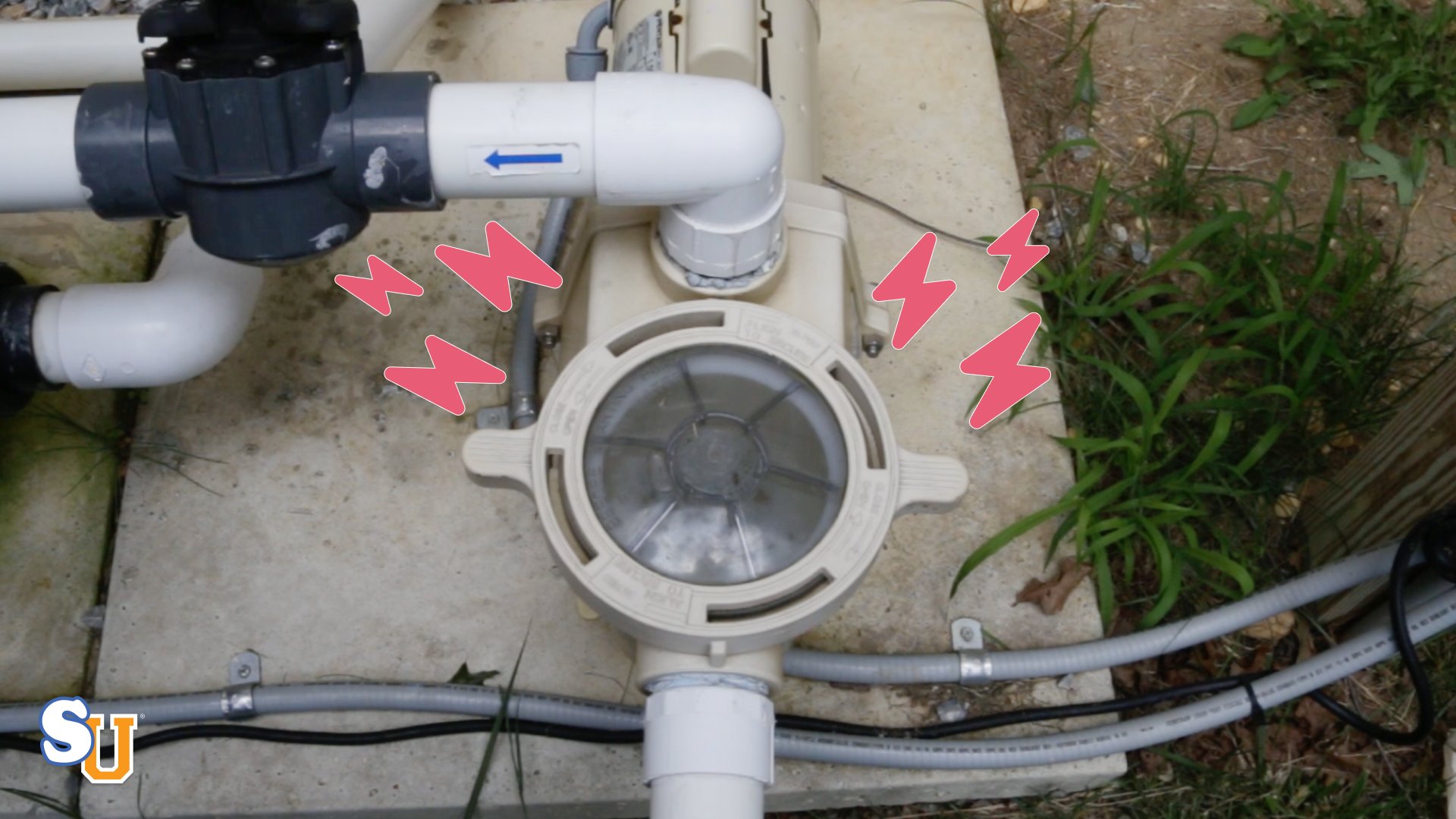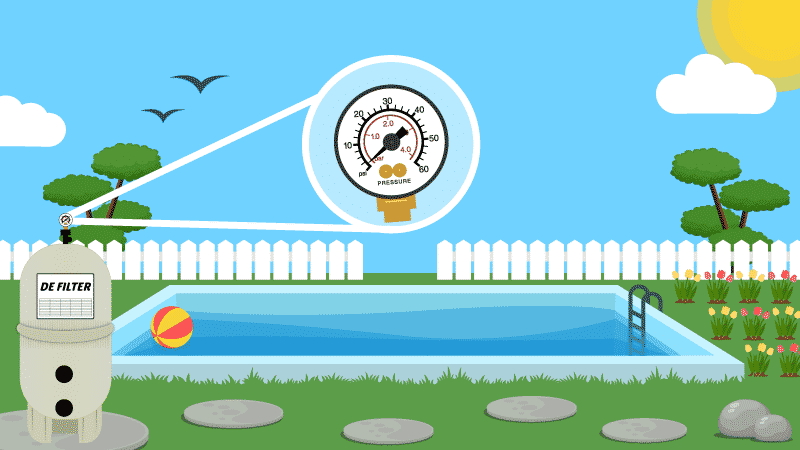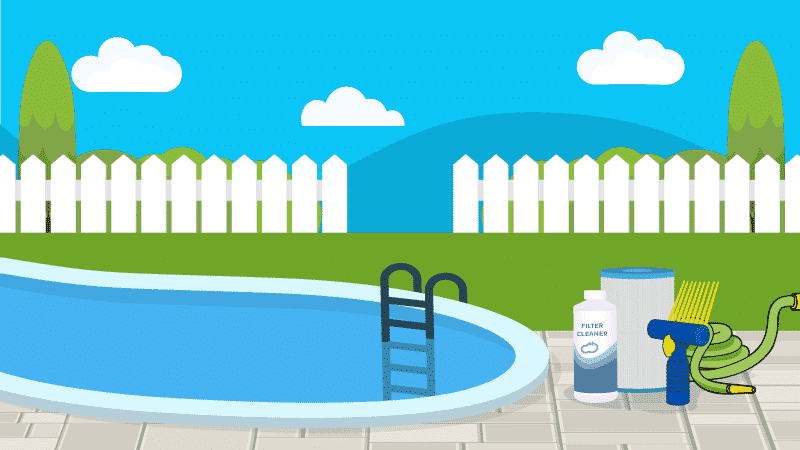How to Backwash a Pool Filter The Right Way
Your pool is only as clean as your filter is. The good news is, when you backwash, cleaning the filter doesn’t always entail taking it apart and washing it by hand.
Here’s a step-by-step guide on how to backwash a pool filter. You can watch the walkthrough video or keep reading for our complete guide.
Stop wasting time and money with confusing water chemistry and maintenance. Our effortless system guarantees to keep your pool balanced, sanitized, and crystal clear all year. Works for all pools including saltwater.
What Is Backwashing a Pool Filter?
Whether you’ve heard the term “backwash a pool filter” or just “backwash a pool,” both are the process of reversing the flow of water in your filter to remove the buildup of contaminants.
As pool water passes through your D.E. filter or sand filter, it leaves behind dirt, oils, and other debris, which are collected in the filter medium—either D.E. powder or sand.
Over time, as water continues to pass in just one direction, the filter medium will become clogged, which will reduce your filter’s effectiveness. When you backwash a pool, you send water backward through the filter, and out the waste or drain port. This forces all the debris caught in the filter to dislodge so you can easily remove it and restore your filtration system back to its normal functioning level.
While backwashing generally works the same way regardless of the type of pool filter, the procedures do vary a bit.
How to Backwash a Sand Filter
When you learn how to backwash a sand filter, the sand never leaves the filter. Water flows backward through the filter system and out your filter’s waste port.
Before you get started, the only extra equipment you’ll need is a backwash hose.
When backwashing your pool filter, use this easy-to-roll up and store backwash hose.
How to Backwash Using a Multiport Valve
- Attach the backwash hose to the waste or backwash port.
- Turn the filter system off.
- Turn the multiport valve to Backwash.
- Turn the filter system back on.
- Let the water run out of the backwash port and through the backwash hose for about a minute, or until the water runs clear
- Turn the filter system off.
- Turn the multiport valve to Rinse.
- Turn the filter system back on.
- Rinse the filter for about 30 seconds.
- Turn the filter system off.
- Turn the multiport valve to Filter.
Important: Never turn the multiport valve handle while the pool filter is on and running. This could cause the rubber diverter gasket inside the valve to come loose or break, which will in turn cause water to leak out of the wrong ports while it’s running.
How to Backwash a D.E. Filter
Before you get started, you’ll need a few supplies.
- Backwash hose
- Diatomaceous earth powder
- One-pound D.E. scoop (or empty one-pound coffee can)
Filter media for backwashing and cleaning D.E. pool filters.
What is Diatomaceous Earth?
It’s a white powder composed of fossilized skeletons of one-celled organisms called diatoms. The powder is added to the filter and attaches itself to the grids inside creating a D.E. “cake.”
This cake, along with the filter grids inside, helps to filter out very fine particles.
How Much D.E. Powder Will You Need?
This will vary depending on the type and size of filter you have. Always refer to your owner’s manual for specific information.
In any case, D.E. powder is measured in pounds, so use a one-pound D.E. scoop to make measuring easy. In a pinch, you can also use an empty one-pound coffee can.

How to Backwash with a Multiport Valve
You’ll want to set aside a little time to do this, but don’t worry. It’s not an arduous task that’s going to take all day.
- Turn off the filter system.
- Connect the backwash hose to the filter’s waste port.
- Turn the multiport valve to Backwash. If you have a push/pull valve, open the backwash gate.
- Turn the filter system back on, and let it run for about two minutes. This will allow pool water to flow out of the backwash valve or port.
- Turn the filter system off.
- Turn the multiport valve to Rinse, turn the system back on, and let it run for about another minute.
- Turn the filter system off.
- Turn the multiport valve back to Filter.
- Add D.E. powder to the filter.
- Refer to your filter owner’s manual to determine how much D.E. powder you’ll need to add.
- Prime the pool pump.
- Remove the strainer basket lid.
- Fill the basket with water, and allow some water to run through the incoming line.
- Turn on the pool pump.
- Mix the appropriate amount of D.E powder with enough water to make a slurry, which is a thin, creamy solution.
- Make sure the pump is running.
- Pour the slurry directly into the pool skimmer.
- Run the pool pump for at least 30 minutes to allow the D.E. to distribute evenly over the filter grids.
Important: Never turn the multiport valve handle while the pool filter is on and running. This could cause the rubber diverter gasket inside the valve to come loose or break, which will in turn cause water to leak out of the wrong ports while it’s running.
How to Backwash with a Push/Pull Valve
This procedure differs only slightly from the multiport valve process.
- Turn off the filter system.
- Connect the backwash hose to the filter’s backwash port.
- Open the backwash gate.
- Turn the filter system back on, and let it run for about three minutes. This will allow pool water to flow out of the backwash port.
- Turn the filter system off.
- Close the push/pull valve.
- Add D.E. powder to the filter.
- Refer to your filter owner’s manual to determine how much D.E. powder you’ll need to add.
- Prime the pool pump.
- Remove the strainer basket lid.
- Fill the basket with water, and allow some water to run through the incoming line.
- Turn on the pool pump.
- Mix the appropriate amount of D.E powder with enough water to make a slurry, which is a thin, creamy solution.
- Make sure the pump is running.
- Pour the slurry directly into the pool skimmer.
- Run the pool pump for at least 30 minutes to allow the D.E. to distribute evenly over the filter grids.
With four large capacity cartridges, this filter provides maximum filter surface area for greater dirt-trapping capacity and longer periods between cleanings. And its easily removable cartridge elements make maintenance fast and easy.
When to Backwash a Pool Filter
When you first set up your filter, whether it’s sand or D.E., take note of the pressure gauge reading. That’s your normal operating filter pressure. Over time, as the filter starts to accumulate dirt and debris, pressure will begin to build up because the water can’t flow as freely through it.
When the pressure gauge reads 10 pounds per square inch (psi) above the normal operating level, it’s time to backwash. If it reads more than 10 psi over the normal level, it’s really time to backwash.
While you could backwash before the pressure reaches the 10 psi over normal mark, we recommend waiting. Yes, your filter functions better when it’s not clogged. But before it gets to the fully clogged point, the presence of small dirt and debris actually helps your sand or D.E. filter work a little better.
Those tiny bits of debris help to catch and stop other tiny bits of debris from getting through the filter medium, and making it back into the pool water.
So, a clean filter is good. A slightly dirty filter is better. A clogged filter is bad, and needs a backwashing.
How to Dispose of Filter Backwash Water
Every time you backwash your pool filter, you could be pulling hundreds of gallons of water from your pool. Where is all that water going to go? Into your yard? The street? The creek behind your house?
None of those are good options, and in fact, may even be illegal, depending on where you live. The water that comes out of your pool is chemically treated, and can damage plant life, groundwater, and aquatic life.
Disposing of backwash water properly is essential, not just to avoid potential fines, but to keep your community and the environment safe from illness and damage.
Storm Drains
Some cities do allow pool water to be released into storm drains. But they may also require that you apply for a permit first.
You may also need to reduce or eliminate chemicals or salt levels in the water before you’re allowed to dispose of it in your community’s sewer system. Check with your local water authority.
Plumbing Cleanouts
You may be able to dispose of backwash water by directing it into one or more of your home’s plumbing cleanouts. Again, it’s best to check with your local water/sewer authority to ensure this is allowed, find out whether you need to treat the water in any way before disposing, and to obtain any necessary permits.
It’s unlikely any municipality will allow you to release pool water into a septic system. You wouldn’t want to do that anyway. Septic systems rely on the existence of active enzymes to dispose of waste. Pouring chemically treated water into the tank—especially water with chlorine in it—would likely kill those enzymes, leaving you with quite a mess.
Dry Wells
These can be a life (or property) saver if you live in an area that sees a high level of rainfall, or experiences tropical storms. They can help prevent flooding and erosion. While a dry well could work for disposing of pool water, that’s not usually its purpose.
Regardless of how many levels of gravel, sand, or other media the water may pass through, it will still end up in the ground, which means it can be a problem if you live in an area that doesn’t allow the disposal of pool water into the ground.
Aside from the issue of permission, a dry well must be constructed by a professional, and it’s a project that can easily cost thousands of dollars.
You can definitely find an easier, safer, and less expensive way to dispose of your filter backwash water. Your local water authority can help you.
Release the Kraken!
Or maybe just some dirty pool water. But keeping a kraken in your pool is all the more reason to keep the water clean. Anyway, when the time comes to backwash your pool, you’ll be ready with the right equipment and procedures.
Take comfort in knowing you’ll be able to help your filter keep your pool clean, which will also help your filter live a longer life, which can save you money. Then you’ll be able to afford that cute little kraken you’ve been wanting to adopt.
Happy Swimming!
4 Ways We Can Help With Your Pool
- Pool Care Cheat Sheets (Free): Easy-to-use downloadable guides to help you keep track of taking care of your pool this year.
- The Pool Care Handbook: An illustrated guide to DIY pool care, including water chemistry, maintenance, troubleshooting, and more.
- The Pool Care Video Course: You’ll get 30+ step-by-step videos and a downloadable guide with everything you need to know about pool maintenance.
- The Pool Care App: Enter your water test results. Get a custom treatment plan. Know exactly what chemicals to add to keep your pool clear.













